|
Location Queenscliff Victoria Equipment Zoom F4 Sennheiser MKH 60 Boom pole array and Roland R09 Handheld We got up early today to drive down to Queenscliff to record some old trains. The Bellarine Peninsula railway is a short tourist railway that is pretty much run by volunteers. They spend their time restoring old engines and carriages and then on weekends they run the trains for the public. Today was a special “Friends of Thomas the Tank Engine” day and so there were going to be lots of people but also a good assortment of vehicles. By getting down there early we could get some material before all the generals public showed up. Anna has started helping me sometimes by taking notes and pictures of things as I record them, I have also been getting her to hold the R09 as a general backup recorder and this has all been really helpful as it means I can race around with the main gear and know that I still have photos being taken and important info being noted down. This makes documenting everything so much easier, and its also a lot more fun having Anna around. The people at the railway were incredibly friendly and helpful and I got access to the trains in ways I wasn’t even hoping for. We both got to ride in the cabin in an old diesel engine as well as a little steam engine, and I was able to get down really close to the underside of the engines as they were running to capture some excellent material. Everyone was aware of safety and being really careful, but we didn’t have the litigation paranoia that seems to be coming the standard everywhere that prevents most people from doing their jobs properly. The collection at Queenscliff is quite large and on the day I was able to sample several engines. Two old Diesel engines from Tasmania, (TGR X class 1950 and a VA1950) one from South Australia and a small steam engine that was used in a quarry in the Geelong area. The diesel engines all had very different and distinctive sounds and even different locations on the same engine provided me with very different results. At one stage the X class was idling in a siding and I walked a 360 degree circle around it while recording. The sound changed dramatically as I walked around the engine. This showed me just how complex sound can be when a single vehicle can produce a considerable number of different sounds just depending on where you are standing in relation to it. I also discovered another benefit to keeping fit and running about 10km every week, as I spent a good 30 minutes running along side some of the engines as they were manoeuvring in the shunting yards. This allowed me to capture longer samples of the engines as they were operating rather than just a “passing” sound as I stood still. There is a bit of a trick to running smoothly so I don’t alter the mics position too much, and I am very thankful for the excellent shock mount that I am currently using as it removes any vibrations as I move. I wouldn’t be able to do this with a quiet sound source as my footsteps would be too audible, but when you are running along side a giant diesel electric driven engine that’s not too much of an issue. 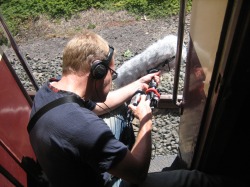 It was quite a warm day, but plenty of sunscreen and a lunch break with awesome chocolate pancakes and plenty to drink made the work easier. Riding in the cabins of the engines was great fun, and the area down at Queenscliff is really beautiful. so in all it was a good way to spend a Sunday as well as being great for recording. The tripod didn't get used today as everything was just far too active for any static microphones.
0 Comments
Location Melbourne Docklands Environment Zoom F4 Sennheiser MKH 60 Tripod Mount and Roland R09 Handheld Back down to the docks for a second try at getting the water sounds I needed. Today was much less windy and with the windshield on the mic I was able to get some good recordings today. Same plan as yesterday but I actually got what I needed today. I took the R09 with me as well just in case. It got a little wet, but that was mainly on the wind cover so I will need to wash the salt water out of it. Afterward I recorded a bunch of tree branches I had collected over xmas. I wanted to get the sounds of branches splitting and snapping. Again the tripod served me well as I was free to use both hands. I got a bunch of samples that I was happy with and now can finally throw away all the branches that have been sitting in a bag on the balcony for about a month. I want to make a few alterations to the tripod set-up, but I can see this is going to become an integral part of my recording set-up. Location Melbourne Docklands Equipment Zoom F4 Sennheiser MKH 60 Tripod Mount For some time now I have been planning a new way of mounting my equipment to make it easier for hands free operation. On a few occasions lately I have needed to use both of my hands when recording and the boom pole set-up has not been very practical. In port Melbourne when I was recording the football sounds I had to strap the boom pole to one of the fence poles pointing in the right direction. This did work alright but a solution like this means I am limited to where I can strap the boom pole to some kind of support. The main issue is that the screw thread size for standard microphone accessories is different to that of camera screw thread. After some hunting around though I found an adapter that converts between the two thread sizes. This will allow me to mount any microphone clip onto any standard camera stand. My new set-up now allows me to attach the windshield system onto a camera tripod. Today I got to test out the new tripod set-up. I am using a standard camera tripod with an adaptor that allows me to attach the Rode shock mount. I haven’t yet built a proper mounting system for it so the H4 itself is just strapped to the tripod with Velcro, but ti works ok for the moment. I needed to record some water splashing sounds, so considering I live about 50 meters from the water I took a bucket and rope and headed down to the docks. The rope was originally to attach to the bucket so I could throw it in the water and pull it out when it filled. It was so windy today that the rope also ended up doubling as an anchor for the tripod. The set-up is actually pretty stable even with the top heavy mic attached, but the wind was just too much for it to stand up, so I attached one end to the tripod, secured it to one of the docks mooring points and then attached the other end to the bucket. I am sure everyone down there thought I was a total nutter as I spent 20 minute hauling buckets of water out of the bay and tossing them across the dock. The cool thing was I didn’t waste a drop of water because it all just ran back into the bay. The wind however was determined to defeat me and the material I recorded was just too contaminated with wind. I guess I’ll be coming back again.
Location Melbourne Cricket Ground Equipment Zoom F4 Sennheiser MKH 60 Boom pole array and Roland R09 Handheld Today is going to be the last of my crowd recording sessions. With this material I should have a good cross section of sporting crowd situations and samples. Today was the first one day match between Australia and South Africa for the 2009 season and a pretty big crowd was expected. I wanted to get there early so I could get a good range of crowd sounds as the number of people there would increase over the day with a surge expected around 6.30 pm when people finished work for the day. By the time I got in the game had started and the second over was being bowled. There would have been between 10,000-15,000 people there by that stage. One of the things I always try to do when I am in a situation where I have pre planned and know I have time to set-up properly is have both the H4 and the R09 running. This increases my chances of catching anything that might be good material. I set the input levels for the R09 at a constant low rate so it can hopefully capture any very loud sounds, and I use the H4 for more specific targeted sounds, often varying the input levels on the H4 through the course of the day. Even when I am relocating from one part of a stadium to another I will usually have one of the devices running just in case something noteworthy comes up. This of course takes its own planning as I was at the MCG for over 6 hours and I needed to ensure I could cover that time with both battery life and recording capacity. Currently the H4 is using a 4 gig SD card which is giving me about 5 hours of recording time at 48 KHz sample rate. I would usually need to change over the batteries if I was going to fill the full five hours. I try to use rechargeable batteries as it can get really expensive otherwise, but I always carry a spare set on me. In the future I plan to get a second H4 but before I do I need to work out the best way to rig it up and what kind of mic set-up I need. The game progressed as expected. Cricket is a slow sport to watch at the best of times. I got lots of material time wise, but most of it was just background crowd chatter. There were actually less sound events in 6 hours of cricket than 90 minutes of soccer., but I got a fairly good selection of cheers and other crowd related sounds. I relocated at least 5 times in at 6 hour session. I also took something to read with me as even though I was recording for all that time, there was very little for me to need to monitor. I am not a big fan of cricket and it can get a little slow at times so I just relaxed and read my book for a lot of the time. This was a long but pretty easy recording session.
Location Port Melbourne Equipment Zoom F4 Sennheiser MKH 60 Boom pole array More sport sounds today. I wanted to get some good kicking sounds recorded, and I needed to go out and pick-up the new cable I had ordered, so it was an afternoon outside for me. It was really bloody hot today 38 C and being out in the sun for over 3 hours was way tiring. When I did finally find somewhere to buy a drink I drank half a litre of water in about 60 seconds because I was so incredibly dehydrated. I am also really glad I put heaps of sun block on because I would have gotten very badly burnt otherwise. All good things to consider when you plan on being outside for a long time, especially in summer in Australia. I picked up my new cable and also ordered some thread adaptors that should allow me to mount the microphone on a standard camera tripod. (more on this later in the week) I walked for about half an hour down to a really large park in Port Melbourne where they had 4 sports ovals. There was a bit of traffic noise from the surrounding roads specifically from the regular semi trailers driving by, but it was infrequent enough to allow me to get some good samples. This is one of the biggest issues about any recording session outdoors. Obviously for things like sports and especially actions like hitting or kicking balls you really need to be outdoors to record. But unless you are lucky enough to live or have access to somewhere very remote there is almost always the issue of background noise and usually its traffic. The advantage of a directional microphone is that it gives you some ability to focus it away from the worst source of background noise. I always make sure I walk into any park area as far as possible and usually try to choose an area with lots of trees. Trees do a really excellent job of absorbing or blocking noise. Then I’ll set-up my microphone so its pointing away from the worst noise and preferably towards the largest area of park. (Hopefully I’ve chosen a day with no people around as well. In this case being nearly 40 degrees certainly helped on that front. No one else was crazy enough to be outside today). I spent about an hour alternating between kicking a rugby ball and a soccer ball. Being there by myself meant I spent more time going and retrieving the balls than I did actually kicking them, but that was ok. I got some very good samples of both balls and made sure I recorded kicking in various styles. From hand, off the ground, drop kicking, bouncing etc. I then added some bounces and other incidental ball noises. On the walk back I managed to record a large industrial complex that has some noisy boiler fans running and a electrical power station that had a good hum sound going. A bloody hot day, but a fairly useful recording session. Location Dalesford Equipment Zoom H4 MKH 60 Boom Pole setup Just a quick one today, Anna and I drove up to Dalesford for a picnic. Dalesford is a beautiful area about an hour west of Melbourne with two really nice lakes. The days was very nice and on the way home I stopped to try and record a windmill, well to be more accurate a wind pump as they are actually used to pump water. These are an icon of the countryside in Australia and can be seen on farms everywhere. What I was really after was one that wasn't quite perfect as I wanted to record it squeaking. We found two of them close to each other on opposite sides of the road. One of them was too new and made no sound when it operated. The second one was suitable squeaky, but it was such a still day that I only captured about 5 seconds of it before the wind died. Even waiting for 15 minutes for it to come back I was out of luck. So I got a tiny bit of material, but the hunt for a windmill continues. Oh yeah, this picture shows exactly why I use the boom pole. Location
Melbourne Equipment Zoom F4 Sennheiser MKH 60 Boom pole array Adding some more sounds to the sports section today. There are going to be a bunch of new sounds for sports over the next few weeks as several of the projects I am working on currently involve sporting sounds. Today it was just some simple sounds of catching various balls. Rugby, soccer and indoor soccer balls all got thrown around a little as I recorded the handling sounds. I did try to record some kicking sounds indoors into a special net but the sounds were very flat. I need to go outside to do this properly so There will be another session next week out in a park somewhere. I am trying to organise some access to various sports events and I have tickets to go to a one day cricket match next week so there will be plenty of stuff there as well. I am always reluctant to record sound indoors without a proper studio (my current workplace doesn't have anything even remotely studio like) reflective sounds and background noise often make it pointless to try and capture material indoors, but depending on the sounds I need and the microphones I use I can often get usable material. Really quiet sounds or sounds with a long duration are not possible, but short sharp impact sounds like catching footballs is pretty easy to record cleanly. The impact itself is loud enough to cover any background noise and the short nature of the sound means there is little chance for contamination. I always try to use an area with the most carpet and soft furniture to absorb reflected sound which I don't want. |
AuthorStephan Schütze has been recording sounds for over twenty years. This journal logs his thoughts and experiences Categories
All
Archives
April 2019
|
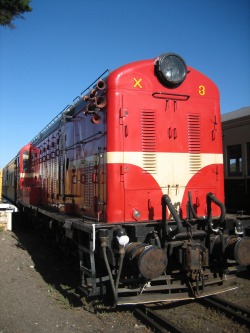


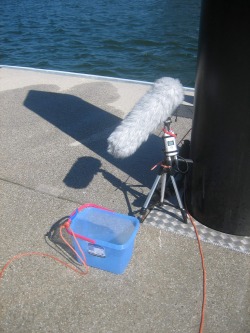
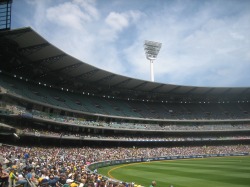

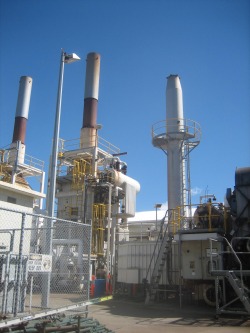
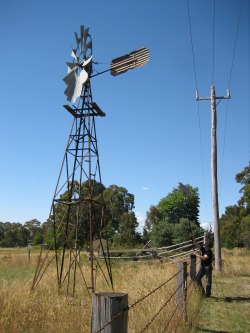
 RSS Feed
RSS Feed
